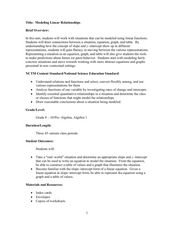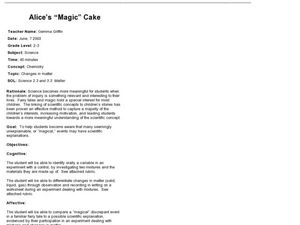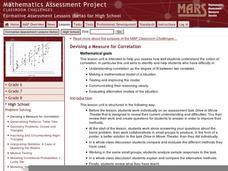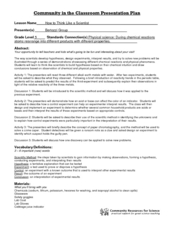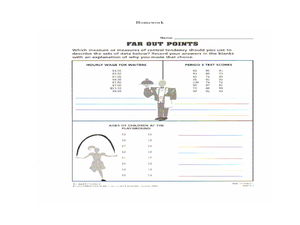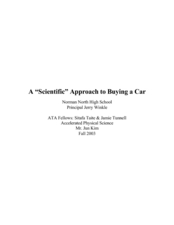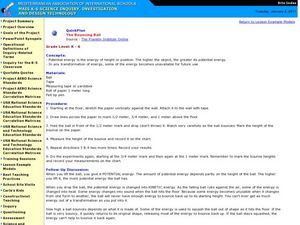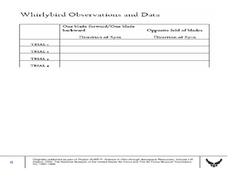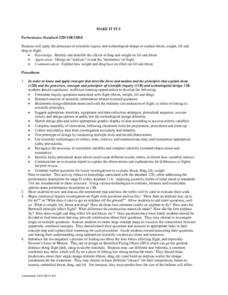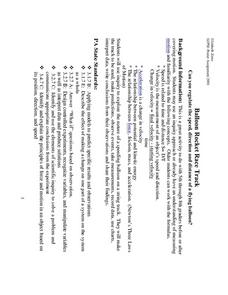Curated OER
Marine Animals on the Move
Young scholars work with partners to track tagged animals using real-time data from satellites. Students gather and analyze data, compile information and conclusions and then prepare a final presentation of their research.
Curated OER
Walking Magic
Students conduct experiment with water striders by placing the insect in two different solutions and discuss their observations. They discover that weight and surface area are important factors in their experiment.
Curated OER
Magic Number
Students create addition sentences. They review number lines and how to jump between numbers to solve equations. They play the "Magic Number" game by using a spreadsheet and guessing numbers. They discuss how they found the magic numbers.
Curated OER
Don't Slip!
Students measure, record, and graph the force of moving a block of wood along sand paper. In this friction lesson plan, students read a spring scale, collect data, construct a graph, and propose a model to explain how fiction works.
Curated OER
Modeling Linear Relationships
Students graph lines using the slope and y-intercept. In this algebra lesson, students create data using tables and equations. They use their data to make predictions and draw conclusion.
Curated OER
Alice Magic Cake
Using a famous children's story as the hook, learners explore the concept of changes in matter. First, they make a cake similar to the one made by Alice in the story Alice's Adventure in Wonderland by Lewis Carroll. Next, they let their...
Curated OER
Devising a Measure for Correlation
How well does your class understand the concept of correlation? Use an activity to explore different methods of calculating correlation. Working alone and then in groups, your class will make decisions on what math to apply to the...
Virginia Department of Education
Transformationally Speaking
Young mathematicians explore transformations of graphs by graphing sets of functions on the same pair of axes. They use their graphs to determine the effect that the values of a and b in y = ax + b have on the graph of y = x.
Virginia Department of Education
A Mystery to Solve
Investigate field properties of real numbers. Scholars use a table for a given operation to determine the identity element. They use the same table to find a missing value in an equation.
Virginia Department of Education
Properties
Examine some properties that don't require a general contractor. Scholars first complete a mental math activity that uses the properties of real numbers. A separate activity formalizes these properties.
Curated OER
Inductive and Deductive Reasoning
Students use logical arguments and inductive reasoning to make or disprove conjectures. After observing a teacher led demonstration, students discover that the deductive process narrows facts to a few possible conclusions. In groups,...
Curated OER
How to Think Like a Scientist
Fifth graders study the scientific method and understand how to apply it. In this "thinking like a scientist" lesson students complete several activities.
Curated OER
China's Population Growth
Learners collect data from China's population growth and determine the mean, median, and mode from the data. In this data lesson plan, pupils determine probabilities and use them to make predictions.
Curated OER
Lesson 2 - Design Process-Measuring Wind Speed
A terrific lesson focused on the design process. It begins with a presentation, "Design: Solve a Problem," which lists the steps of the process and then introduces the specific challenge: to build a device that measures wind speed....
Curated OER
A “Scientific” Approach to Buying a Car
Young scholars examine what it takes to purchase a car and the resources out there to help find what you are looking for. For this scientific method lesson students complete different problem solving situations.
Curated OER
The Bouncing Ball
Learners use the scientific method to conduct an experiment to test how a ball bounces. In this inquiry-based physical science and scientific method activity, students drop a ball from specified heights and record the rebound, then...
Curated OER
Principles of Flight: Gyrocopter and the Scientific Method
Students explore the concept of the scientific method. In this investigative lesson plan, students investigate which direction the blades will spin on a gyrocopter. Student will practice using the scientific method to complete the...
Curated OER
MAKE IT FLY
Students utilize the process of scientific inquiry and technological design to explain thrust, weight, lift and drag in flight. They design an "airplane" to test the "mechanics" of flight. In addition, they brainstorm and sketch a design...
Curated OER
My Car Has Potential
Seventh graders investigate how changes in the mass or height of a ramp can affect the change in potential energy. They discuss the concepts of work and energy, then using the four question strategy, they design an experiment that...
Curated OER
Me And My Shadow
Students investigate the concept of a shadow. They design a tool to create shadows for an experiment. They make observations and record the size and shape of shadows. The lesson contains background information for the teacher to deliver...
Curated OER
Ziplock Chemistry
Students investigate various chemical reactions when creating mixtures in ziplock baggies. In this chemistry lesson, students will recognize various chemical reactions and cite evidence. Safety and assessment strategies are included in...
Curated OER
Balloon Rocket Race Track
Students discuss "How can we measure (or make it easier to record) the speed, distance or acceleration of the balloon?" They told that they are going to make a balloon racetrack. Pupils use meter sticks to accurately measure length and...
Curated OER
The Solar Cycle
Students research the solar cycle. In this Science lesson, students use the internet to investigate the solar cycle. Students produce a spreadsheet and graph from the information collected.
Curated OER
Related Rates
Twelfth graders rewrite word problems using equations. In this calculus activity, 12th graders solve real world situation using the derivative. They solve problems on rate, and distance.




